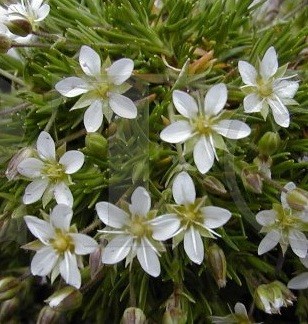California sandwort
(Sabulina californica)

Description
Minuartia californica, commonly known as California sandwort, is a species of flowering plant in the family Caryophyllaceae. It is native to valleys, foothills, and mountains in California and Oregon. It grows in many types of habitat, including chaparral, vernal pools, and roadsides. Minuartia californica is a small annual herb producing a hair-thin stem no more than 12 centimeters tall, in erect or spreading, branching form. The narrow leaves are just a few millimeters long and under 2 millimeters wide. The tiny flower has five white petals and five veined, pointed sepals. Minuartia is a genus of flowering plants commonly known as sandworts in the family Caryophyllaceae. Minuartias are small annual or perennial plants which grow in otherwise inhospitable conditions such as on rocky ledges and in stony soil. The genus is widely distributed in the northern hemisphere, mainly distributed in Europe, in the Mediterranean region, and north Africa, southwest Asia, and the Caucasus Mountains. Many Minuartia species were formerly classed in the genus Arenaria, and the obsolete genus Alsine. In 2014, the polyphyletic Minuartia sensu lato was recircumscribed, with many of the species transferred to other genera, including Cherleria, Eremogone, Facchinia, Mcneillia, Minuartiella, Mononeuria, Pseudocherleria, Rhodalsine, Sabulina, and Triplateia. Minuartia sensu stricto is characterized by the following features: leaves linear-setaceous; 5 acute sepals with 3, 5, or 9-veins; 5 white petals; 3 styles, forming 3-parted capsules. The genus was named for Juan Minuart (1693–1768), a Spanish botanist and pharmacist.
Taxonomic tree:







